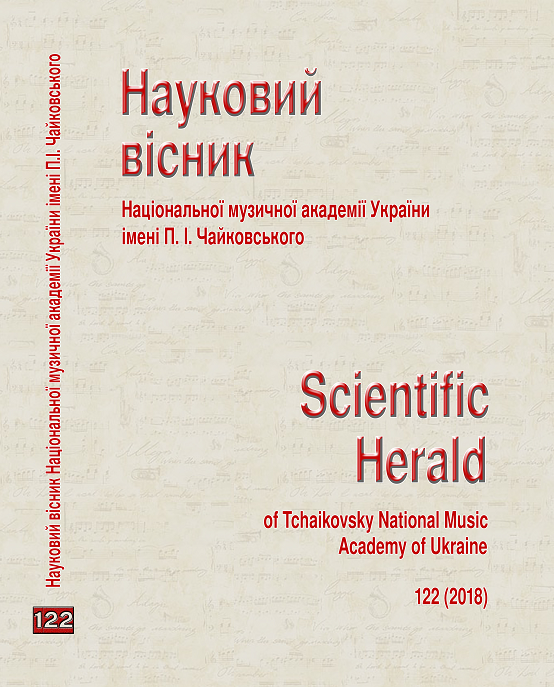Intonational unity as an integration factor of idea (on the example of Hennady Liashenko's Second Concerto for Cello and Orchestra)
DOI:
https://doi.org/10.31318/2522-4190.2018.122.141804Keywords:
intonational unity, leitcomplex, creation G. Lyashenko, concert, celloAbstract
Relevance of the study. The second concert for cello and orchestra by Gennady Lyashenko acts as a model of a work that combines the achievements of modern composer thinking, an extremely profound philosophical meaning and an intimate lyric type of expression. One of the integrating factors of the concert is intonational unity. The disclosure of the specifics of the implementation of this principle on the example of G. Lyashenko’s work is a topical research that will not only help to shape the notion of the specifics of his compositional individual style, but can also become a kind of guidebook for future generations of creators. Main objective of the study is to highlight the role of intonation unity as the factor of the integration of the idea, on the example of the Second Concerto for cello and orchestra G. I. Lyashenko. The research methods are about analyzing the intonational structure of the concerto for cello and orchestra. How the study was done The main leitcomplex and the pathways of its growth are identified and tracked in all sections of the work.
Results and conclusions. In the Second concert for cello and orchestra by G. Lyashenko, the main intonation core, taking into account its transformations, has considerable flexibility, appealing to the already established genre and stylistic "signs" of musical thinking. If the intonation in the concert is a factor of the temporal and semantic integration of the work, then the textural, mood-harmonic, orchestral and stylistic devices are the factors of differentiation in the respective areas. This is a unique example of a musical idea, where intonational unity is the central semantic factor in relation to other aspects of musical thinking. Practical significance. Taking into account a strong connection with the traditions that have developed in the national composers' school in domestic art practice combining with personal creative methods, makes the highlighting of the potential of the intonational unity, as an integration factor, is considered a promising approach worthy of imitation.
Downloads
References
Vrublevskyi, V. (2017), “Conductor's interpretation of concert # 2 for cello and orchestra Hennady Liashenko”, Molodyi vchenyi [Young Scientist], vol. 7, pp. 63-67 [in Ukrainian].
Rzhevska, M. “The word about the master”, available at: http://www.kdam.kiev.ua/shevchenko/lyashenkoshv.htm (accessed 31 march 2018) [in Ukrainian]
Downloads
Published
How to Cite
Issue
Section
License
Our journal abides by the CREATIVE COMMONS copyright rights and permissions for open access journals.
Authors, who are published in this journal, agree to the following conditions:
The authors reserve the right to authorship of the work and pass the first publication right of this work to the journal under the terms of a Creative Commons Attribution License, which allows others to freely distribute the published research with the obligatory reference to the authors of the original work and the first publication of the work in this journal.
The authors have the right to conclude separate supplement agreements that relate to non-exclusive work distribution in the form in which it has been published by the journal (for example, to upload the work to the online storage of the journal or publish it as part of a monograph), provided that the reference to the first publication of the work in this journal is included.




